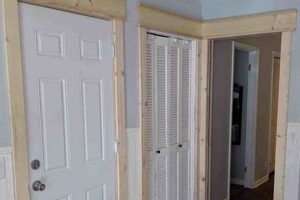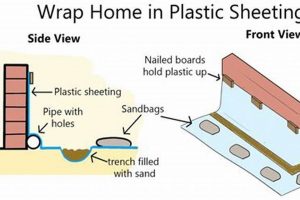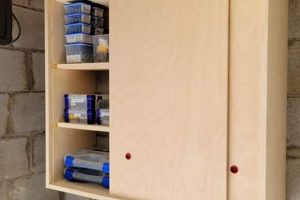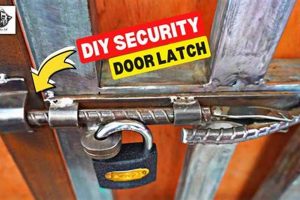A door divided horizontally allows the top half to open independently while the bottom remains closed. This design, often realized through do-it-yourself projects, offers a unique combination of access and security. A practical example involves modifying an existing standard door by cutting it in half and installing hinges and a latching mechanism to operate the two sections independently.
This type of door provides several advantages. It permits ventilation and light while restricting the movement of children or pets. Historically, this design was prevalent in stables and farmhouses, enabling caretakers to tend to animals or homes while maintaining a barrier. This functionality continues to be valuable in contemporary settings.
The subsequent sections will detail the materials, tools, and step-by-step instructions required to construct such a door, along with considerations for safety and aesthetic customization. Furthermore, potential challenges and troubleshooting tips will be addressed to ensure a successful outcome.
Essential Considerations for Crafting a Divided Door
Achieving a functional and aesthetically pleasing divided door requires meticulous planning and execution. The following guidelines address critical aspects of the construction process.
Tip 1: Material Selection: Prioritize durable, weather-resistant materials suitable for exterior use, such as solid wood or composite options. This choice directly impacts the longevity and structural integrity of the divided door.
Tip 2: Precise Measurements: Accurate measurements are paramount. Ensure precise alignment during the cutting process to guarantee proper closure and prevent gaps between the upper and lower sections.
Tip 3: Hinge Placement: Utilize heavy-duty hinges designed to support the weight of each door section. Strategic placement and secure fastening are crucial for smooth operation and preventing sagging.
Tip 4: Latching Mechanism: Select a robust latching system that securely joins the top and bottom halves. Consider a barrel bolt or a specialized Dutch door latch for enhanced security and stability.
Tip 5: Weather Stripping: Apply weather stripping around the perimeter of both door sections to minimize drafts and prevent water infiltration. This contributes to energy efficiency and protects against the elements.
Tip 6: Professional Consultation: If lacking carpentry experience, consult a qualified professional. This minimizes the risk of errors and ensures the project adheres to safety standards.
Tip 7: Finishing and Sealing: Apply a protective finish, such as paint or sealant, to all exposed surfaces. This shields the wood from moisture, UV damage, and insect infestation, extending the lifespan of the door.
Adhering to these considerations enhances the functionality, durability, and aesthetic appeal of the divided door, providing a long-lasting and visually pleasing addition to the home.
The subsequent conclusion will summarize the key steps involved in constructing a divided door and highlight its potential benefits.
1. Precise Alignment
Precise alignment is fundamentally critical to the functionality and aesthetic appeal of a divided door. The horizontal cut dividing the door creates two independent sections, each requiring accurate positioning relative to the other and the door frame. Misalignment results in functional impairments, such as difficulty latching the two sections together, uneven weather sealing, and compromised structural integrity. Consequently, any deviation from strict alignment principles directly affects the usability and longevity of the finished product.
The connection between precise alignment and the successful completion of the project is a direct cause-and-effect relationship. When the cut is not perfectly horizontal or the sections are not reassembled with absolute precision, the latching mechanism will not engage correctly, rendering the primary benefit of a divided door selective opening unusable. Furthermore, gaps caused by poor alignment allow drafts and moisture penetration, undermining the door’s ability to provide insulation and weather protection. In practical applications, even a small fraction of an inch of misalignment can necessitate extensive rework or, in extreme cases, render the project a failure.
In summary, the success of a project hinges on achieving and maintaining precise alignment throughout the cutting, assembly, and installation phases. Addressing alignment challenges proactively, utilizing appropriate measuring tools, and employing meticulous assembly techniques mitigates the risks associated with misalignment. Therefore, this aspect is not merely a procedural detail but a foundational requirement for achieving a functional and aesthetically pleasing divided door.
2. Secure Latching
Secure latching is a critical component of any divided door, directly impacting its functionality, security, and overall usability. The ability to independently operate the top and bottom sections relies heavily on a reliable mechanism to join these halves when desired, ensuring structural integrity and preventing unwanted separation.
- Latch Mechanism Selection
The selection of a suitable latch mechanism is paramount. Options range from simple barrel bolts to specialized Dutch door latches designed for this specific application. The chosen mechanism must provide sufficient holding force to withstand typical use, environmental factors, and potential attempts to force the door open. The design of the latch should also complement the overall aesthetic of the door.
- Installation Accuracy
Even the highest quality latch will fail if improperly installed. Precise alignment during installation is crucial to ensure smooth engagement and disengagement of the latch. Misalignment can lead to difficult operation, premature wear, and ultimately, failure of the latching mechanism. Attention to detail during installation is thus essential for long-term reliability.
- Material Durability
The materials used in the latching mechanism must be durable and resistant to corrosion, especially in exterior applications. Exposure to moisture and fluctuating temperatures can degrade less robust materials, leading to weakened holding strength and eventual failure. Stainless steel or other weather-resistant materials are often preferred for their longevity and reliability.
- Security Considerations
Beyond basic functionality, secure latching contributes to the overall security of the entry. A weak or easily bypassed latch provides a vulnerable point of entry. Reinforcing the latching mechanism with additional hardware, such as strike plates, can enhance security and deter unauthorized access. The level of security required will depend on the intended use and location of the divided door.
In conclusion, secure latching is an indispensable element of the divided door. The appropriate selection, careful installation, durable materials, and consideration of security needs are all crucial factors in ensuring the long-term performance and usability of the door. A well-executed latching system not only allows for the intended functionality of a divided door but also provides peace of mind regarding security and structural integrity.
3. Durable Hinges
The functionality and longevity of a do-it-yourself divided door are intrinsically linked to the quality and suitability of the hinges employed. These hardware components bear the entire weight of the upper and lower sections, enduring repeated stress from opening, closing, and environmental factors. Consequently, selecting hinges designed for durability is paramount to the success of the project.
- Weight Capacity and Load Bearing
The primary function of hinges is to support the weight of the door sections. Selecting hinges with an adequate weight capacity, exceeding the actual weight of each section, is crucial for preventing sagging and maintaining proper alignment. For instance, solid wood doors require heavier-duty hinges compared to lighter, hollow-core alternatives. Exceeding the rated load can lead to premature wear, compromised operation, and eventual failure of the hinges.
- Material Composition and Corrosion Resistance
The material composition of the hinges directly affects their resistance to corrosion and environmental degradation. Exterior divided doors are exposed to rain, sunlight, and temperature fluctuations, necessitating the use of corrosion-resistant materials such as stainless steel or coated steel. Using hinges susceptible to rust can result in weakened structural integrity and eventual failure, requiring costly repairs or replacements.
- Hinge Type and Application Suitability
Different hinge types offer varying levels of support and operational characteristics. Butt hinges are a common choice, but specialized hinges, such as ball-bearing hinges, provide smoother operation and increased durability for heavier doors. The selection of an appropriate hinge type, tailored to the specific design and usage patterns of the divided door, is essential for optimal performance and longevity. Using the incorrect hinge type can lead to binding, uneven wear, and compromised functionality.
- Installation Integrity and Secure Fastening
Even the most durable hinges are rendered ineffective if improperly installed. Securely fastening the hinges to both the door frame and door sections is paramount to ensuring stability and preventing loosening over time. Utilizing appropriate screws or bolts, properly sized for the hinge and substrate material, is essential for achieving a robust connection. Improper installation techniques can lead to hinge failure, misalignment, and compromised security.
The selection and installation of durable hinges represent a critical investment in the long-term performance and functionality of a do-it-yourself divided door. Prioritizing weight capacity, corrosion resistance, hinge type suitability, and installation integrity ensures that the door operates smoothly, withstands environmental challenges, and provides reliable service for years to come. The hinges effectively serve as the linchpin of the entire structure.
4. Material Suitability
Material suitability is a cornerstone of a successful do-it-yourself divided door project. The chosen materials dictate the door’s longevity, structural integrity, weather resistance, and aesthetic appeal. Incorrect material selection can lead to premature failure, increased maintenance, and compromised security.
- Wood Species and Durability
The selection of wood species significantly impacts the door’s resistance to rot, insect infestation, and warping. Durable hardwoods, such as oak or mahogany, offer superior resistance compared to softwoods like pine. Exterior applications necessitate pressure-treated lumber or naturally decay-resistant species to ensure longevity. The use of inappropriate wood can lead to structural failure and necessitate frequent repairs.
- Panel Composition and Stability
For panel inserts within the door, the composition of the panel material influences its stability and resistance to moisture. Solid wood panels are prone to expansion and contraction with humidity changes, potentially causing warping or cracking. Engineered wood products, such as plywood or medium-density fiberboard (MDF), offer greater dimensional stability but may require careful sealing to prevent moisture damage. The chosen panel material must withstand the elements to maintain the door’s integrity.
- Hardware Compatibility and Load Distribution
The selected materials must be compatible with the chosen hardware, including hinges, latches, and handles. The weight and density of the door sections dictate the required strength of the hardware. Using lightweight materials with heavy-duty hardware or vice versa can lead to uneven load distribution and premature failure. Ensuring compatibility between materials and hardware is crucial for smooth operation and long-term reliability.
- Finish and Weather Protection
The chosen finish directly impacts the door’s resistance to weathering and UV damage. Exterior-grade paints, stains, and sealants provide a protective barrier against moisture, sunlight, and temperature fluctuations. Inadequate finishing can lead to discoloration, cracking, and eventual degradation of the underlying material. Regular maintenance and reapplication of the finish are necessary to prolong the door’s lifespan and maintain its aesthetic appeal.
The interplay between these material characteristics directly influences the long-term performance and cost-effectiveness of a divided door. Selecting appropriate materials requires careful consideration of the intended application, environmental conditions, and desired aesthetic. A well-informed material selection process mitigates risks, ensures structural integrity, and contributes to a visually appealing and functional finished product.
5. Weatherproofing
Weatherproofing is an indispensable aspect of constructing a do-it-yourself divided door, particularly for exterior applications. The inherent design, with its horizontal division, presents a unique challenge in preventing air and water infiltration, necessitating careful attention to detail and the implementation of specific strategies.
- Sealing the Horizontal Joint
The horizontal joint between the upper and lower sections of the divided door is a primary entry point for drafts and moisture. Effective sealing requires the application of weather stripping or gasketing along the meeting surfaces. The chosen material must be durable, flexible, and capable of maintaining a tight seal even with repeated opening and closing. Failure to properly seal this joint can result in energy loss, water damage, and compromised comfort within the building.
- Addressing Gaps Around the Door Frame
Gaps between the door frame and the surrounding wall represent another potential source of air and water leakage. Caulking or weather stripping can be used to seal these gaps, creating a continuous barrier against the elements. Proper installation requires careful surface preparation and the selection of a sealant appropriate for the materials involved. Inadequate sealing around the door frame can diminish the effectiveness of other weatherproofing measures.
- Implementing Effective Drainage
Water accumulation at the base of the door can lead to rot and decay. Implementing effective drainage mechanisms, such as a sloped threshold or a drip edge, helps to divert water away from the door and prevent it from pooling around the base. The design should minimize the potential for water to enter the structure and prolong the lifespan of the door. Neglecting drainage considerations can result in significant structural damage over time.
- Selecting Weather-Resistant Materials
The choice of materials directly influences the door’s ability to withstand the elements. Exterior-grade wood, composite materials, or metal offer superior resistance to moisture, UV radiation, and temperature fluctuations. Pressure-treated lumber or naturally decay-resistant wood species are often preferred for their longevity in exposed environments. Utilizing materials susceptible to rot or warping can compromise the door’s weatherproofing capabilities and necessitate frequent repairs or replacements.
These facets of weatherproofing are interconnected and contribute to the overall performance of the divided door. A comprehensive approach, addressing each potential point of vulnerability, is essential for creating a durable, energy-efficient, and comfortable entry point. Neglecting weatherproofing considerations can negate many of the benefits associated with this type of door, leading to increased energy consumption and structural issues.
6. Safety Compliance
Construction of a do-it-yourself divided door necessitates adherence to established safety standards and building codes. These regulations exist to protect individuals from potential hazards associated with structural modifications, ensuring the safety of occupants and preventing property damage. Failure to comply with these standards can result in legal repercussions, increased risk of injury, and compromised structural integrity. A primary example is the requirement for fire-rated doors in specific locations, which a DIY project might inadvertently compromise if not constructed according to code. The absence of proper safety compliance directly correlates with an elevated probability of accidents and structural instability.
Practical application of safety compliance principles involves several key considerations. First, a thorough understanding of local building codes is essential before commencing any modification. This includes requirements for door dimensions, fire ratings, and hardware specifications. Second, the selection of appropriate materials and construction techniques must align with these regulations. For instance, using non-fire-rated materials in a designated fire barrier can render the door non-compliant and pose a significant safety risk. Third, proper installation of all components, including hinges, latches, and weather stripping, is critical to ensure the door functions as intended and meets safety standards. This proactive approach minimizes the likelihood of safety hazards and ensures the door performs reliably in various conditions.
In summary, safety compliance is not merely an ancillary consideration but an integral component of any DIY divided door project. Neglecting this aspect can lead to severe consequences, ranging from legal penalties to compromised safety and structural integrity. By prioritizing adherence to established safety standards, individuals can mitigate risks and ensure the creation of a functional and safe divided door. This understanding underscores the practical significance of integrating safety compliance into every stage of the construction process, from initial planning to final installation.
Frequently Asked Questions Regarding DIY Dutch Door Construction
The following addresses common inquiries concerning the process of creating a divided door, offering concise and informative responses.
Question 1: Is the modification of an existing door permissible under building codes?
Building codes vary significantly by locality. It is imperative to consult local regulations to ascertain whether modifications to existing doors, particularly those affecting fire ratings or structural integrity, are permitted without specific permits or inspections.
Question 2: What are the primary structural concerns when dividing a door?
The primary structural concern involves maintaining the door’s stability after the horizontal cut. Reinforcement of the top and bottom sections, particularly around the cut edge, is often necessary to prevent warping or sagging. The selection of appropriate hinges and latching mechanisms is also critical for ensuring the long-term structural integrity of the door.
Question 3: How is a proper seal achieved between the upper and lower sections?
A proper seal is typically achieved through the application of weather stripping or gasketing along the meeting surfaces of the upper and lower sections. The choice of material should be durable and resistant to compression, ensuring a tight seal against air and water infiltration.
Question 4: What type of latch is recommended for a divided door?
Specialized Dutch door latches are specifically designed for this application, providing a secure and reliable connection between the upper and lower sections. These latches often incorporate features that prevent accidental disengagement and offer enhanced security compared to standard latches.
Question 5: What tools are essential for undertaking this type of project?
Essential tools include a circular saw or track saw for making precise cuts, a router for creating clean edges and hinge mortises, a drill for installing hardware, a level for ensuring alignment, and measuring tools for accurate measurements. A well-equipped workshop is highly recommended for achieving professional results.
Question 6: Is prior carpentry experience required to construct a divided door?
While not strictly required, prior carpentry experience is highly beneficial. The project involves precise cutting, assembly, and installation, requiring a degree of skill and attention to detail. Individuals lacking experience may benefit from seeking guidance from a qualified carpenter or consulting detailed instructional resources.
These answers provide a foundational understanding of essential considerations for creating a divided door. Careful planning and execution are crucial for ensuring a successful outcome.
The subsequent conclusion will summarize the key steps involved in constructing this type of door and highlight its potential benefits.
Conclusion
The preceding discussion has elucidated the multifaceted aspects of the do-it-yourself divided door, encompassing design considerations, material selection, construction techniques, safety compliance, and frequently encountered challenges. Key points include the necessity for precise alignment, secure latching mechanisms, durable hinges, suitable materials, effective weatherproofing, and strict adherence to building codes. Each element contributes significantly to the functionality, longevity, and safety of the final product.
Successful implementation of a “diy dutch door” requires a meticulous approach, combining technical proficiency with a thorough understanding of applicable regulations. The potential benefitsenhanced ventilation, controlled access, and aesthetic appealmust be weighed against the complexities inherent in this type of project. Prospective builders should carefully assess their skills and resources before embarking on this endeavor to ensure a satisfactory and safe outcome.







